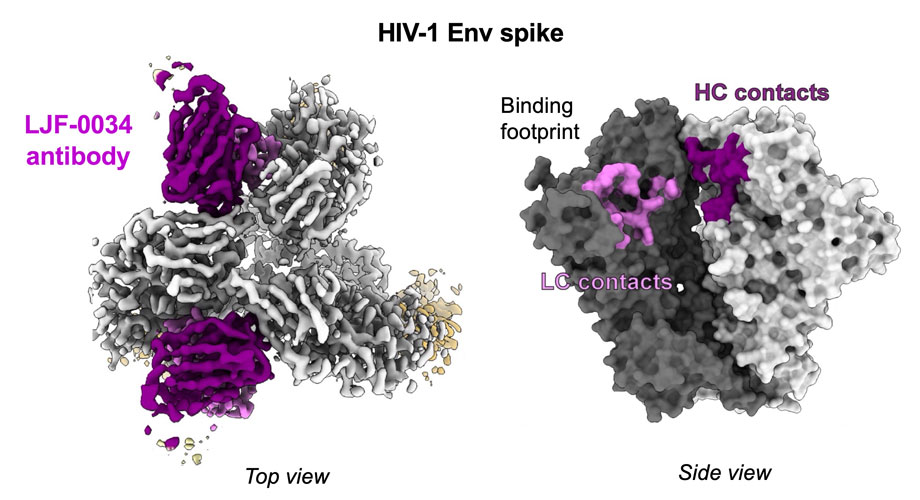Will RFK Jr. kill this research too?
Scripps Research Institute
An electron density map illustrating how the new antibody (purple) neutralizes HIV by binding across two sections of the spike protein (gray). Credit: Scripps Research
In the long battle to create an effective HIV vaccine,
scientists have made a major leap forward. A new study shows that a series of
vaccines can coax the immune system to produce powerful antibodies capable of
blocking a wide range of HIV strains -- including those that are typically the
hardest to stop.
Published in Immunity on May 7, 2025, the
research comes from a collaboration led by scientists at Scripps Research and
Sweden's Karolinska Institute. Their results mark a strong demonstration that
broadly neutralizing antibodies (bNAbs) -- long considered a key goal for HIV
vaccination -- can be successfully induced in nonhuman primates. It also points
to a new target on the HIV spike protein that future antibodies may be able to
successfully bind to block the virus.
"What sets this work apart is that we didn't just see initial signs of a promising response; we actually isolated functional broadly neutralizing antibodies and pinpointed exactly where they bind on the surface of the virus," says senior author Richard Wyatt, professor in the Department of Immunology and Microbiology at Scripps Research. "This tells us not only that the approach works, but also specifically why it works."
Because HIV rapidly mutates and there are literally millions
of different strains circulating in humans around the world, scientists have
focused their research efforts on creating vaccines that can stimulate the body
to produce bNAbs that simultaneously recognize many strains at once. While some
people spontaneously produce bNAbs after exposure to HIV, it has been a
challenge to create a vaccine that reliably induces bNAbs in nonhuman primates
or humans.
A two-step strategy
In the new work, Wyatt and his team first designed a mimic
for the HIV spike protein -- a key section of HIV's machinery that antibodies
target to block infection. Unlike earlier designs, the new "spike
mimics" don't fall apart after injection and closely resemble the HIV
spike protein's structure.
Then, the group turned to a two-step vaccination strategy.
First, they primed the immune system with a version of the spike mimic that
lacked key sugar molecules, which normally coat the protein and make it harder
to recognize. This helped expose a critical, conserved region of the spike: the
CD4 binding site, where the spike protein attaches to human immune cells.
After two sequential doses of the priming vaccine, five
boosters were administered, each about twelve weeks apart. This booster series
of spike proteins from different HIV strains -- now with their sugar coat
intact -- retrained the immune system to recognize the same region even when it
was partially hidden.
The deliberate sequence of vaccines, the researchers say,
was key to success. "We weren't just vaccinating at random," says
Javier Guenaga, a senior staff scientist at Scripps Research and co-first
author of the new paper. "This was a rational, structure-guided approach
to elicit the right kinds of antibodies."
Encouraging results
The approach paid off. Several of the vaccinated animal
models produced antibodies that could neutralize "tier 2" HIV
strains, which are among the hardest to block. From one animal model,
researchers isolated a family of antibodies, named LJF-0034, that neutralized
nearly 70% of a global panel of 84 HIV strains.
"It is incredibly exciting to see a vaccine generate
this kind of breadth in nonhuman primates," says senior staff scientist
Shridhar Bale, a co-first author of the work. "And it's not just a
one-off. We saw responses targeting this site in multiple animals."
The group then showed that antibodies like LJF-0034 bound to
a previously undescribed site on the virus, bridging two sections of the spike
protein. Future research can help guide the development of additional vaccines
targeting this new, promising site. Wyatt says his team would like to optimize
the vaccine so that it can reliably elicit LJF-0034-like responses in a greater
fraction of recipients.
Ultimately, an effective HIV vaccine regimen will likely
include a combination of vaccines that yield different bNAbs, all acting
together.
"This is far from a final vaccine," says Wyatt.
"But having a new, highly effective target is incredibly exciting and will
help shape our efforts moving forward."
One vaccine candidate used in this study is already being
tested in a phase 1 clinical trial, with early results expected soon. In that
trial, human participants are receiving the same spike protein (lacking sugar
molecules) used as the priming vaccine in this study.
In addition to Wyatt, Bale, and Guenaga, authors of the
study, "Vaccination of nonhuman primates elicits a broadly neutralizing
antibody lineage targeting a quaternary epitope on the HIV-1 Env trimer,"
include Richard Wilson, Jocelyn Cluff, Esmeralda D. Doyle, Gabriel Ozorowski,
Xiaohe Lin, Leigh M. Sewall, Wen-Hsin Lee, Shiyu Zhang, Ian A. Wilson, and
Andrew B. Ward of Scripps Research; Fabian-Alexander Schleich, Monika Àdori,
Xaquin Castro Dopico, Mark Chernyshev, Alma Teresia Cotgreave, Marco Mandolesi,
Martin Corcoran, and Gunilla B. Karlsson Hedestam of the Karolinska Institutet;
Sijy O'Dell and Nicole A. Doria-Rose of the National Institute of Allergy and
Infectious Diseases; Brandon S. Healy, Deuk Lim, Vanessa R. Lewis, Diane
Carnathan, and Guido Silvestri of Emory University; and Elana Ben-Akiva and
Darrell J. Irvine of the Massachusetts Institute of Technology.
This work was supported by funding from HIVRAD (P01 AI104722, P01 AI157299, P01 AI124337), Scripps CHAVD (UM1 AI144462), the James B. Pendleton Trust, the Swedish Research Council (2017-00968) and the Emory National Primate Research Center (ORIP/ODP51OD011132, U42PDP11023).
